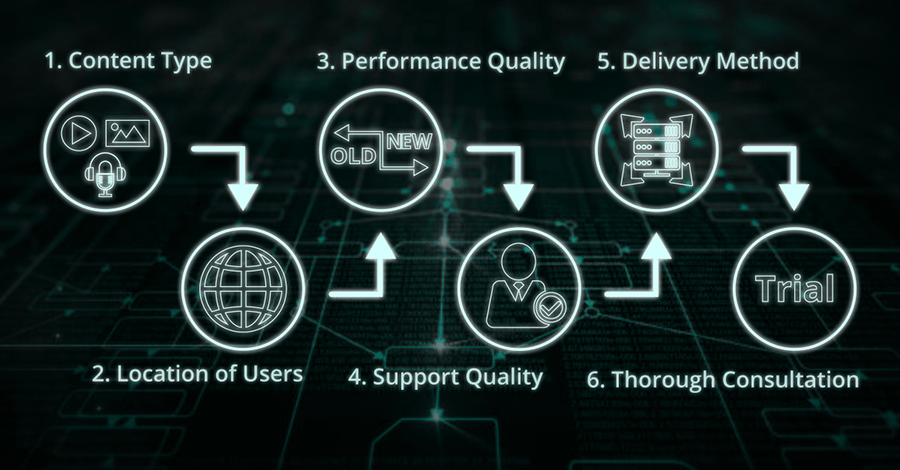6 Tips for Choosing a Content Delivery Network

How many times have you heard that content is king? If you’re in the content creation business, probably more times than you care to remember. But if you can’t get your content to your audience in a timely fashion, your king has just been dethroned.
For IT organizations, content is more than just a viral video or Tweet-worthy news story. Your web resources are the face of the business to the rest of the world and your business-critical applications house the content employees, customers, and partners need every day. Those resources and applications are your crown jewels, and all of that content must be delivered at the speed users expect no matter what industry or sector you are in.
Enterprises today are spending millions of dollars to ensure that their end users have the best possible web experiences. That’s why the Content Delivery Network (CDN) market is on the rise.
However, it’s easy to become overwhelmed when considering CDN providers. There are dozens of options on the market and IT decision makers need to keep a few things in mind when trying to choose the right one:
1. What type of content will you deliver?

This seems like a basic question, but it’s an important one — and one that you as an IT leader might not necessarily know without talking to your business stakeholders.
As you might imagine, different types of content require different solutions. Photo and video content requires much more bandwidth than text content, and the need increases when the content becomes dynamic and personalized.
If most of your content is static, evaluate vendors that have a good number of POPs dedicated to your resources. It’s common for CDN vendors to boast about the size of their networks in terms of the number of servers or POPs they have around the world. But the key question for savvy CDN consumers is: How much of that POP footprint (and those servers) is guaranteed to be available for your content?
For dynamic content, “bigger” is not an advantage at all. What matters is the quality of the end-to-end connectivity, the intelligence of the middle mile, and the optimization software stack.
There are CDNs that do a fairly decent job at caching video or long-tail content locally. If you are a streaming media company, go for it! But if you’re an enterprise with premium delivery requirements, and you have business users accessing your website frequently, you better watch out for their global cache eviction policy. In those cases, look for CDNs that have an enterprise focus.
If you intend to accelerate your customer-facing portals or web applications — or for that matter, any dynamic, personalized or bi-directional web content — caching isn’t going to help. Instead, you need to look for vendors that offer dynamic site acceleration services.
2. Where in the world are your most important users?

Content knows no boundaries and doesn’t care whether someone is viewing it in California or Croatia. The most important thing for an organization is to ensure that people have the same quality experience with your content no matter where in the world they are located.
This can have a huge bearing on your CDN purchase decision. How well can the chosen solution scale with your business? Will it involve significant additional expense? Do you have a significant end user presence in China? In India? In Europe?
Organizations need to ensure that their CDN provider has POPs that are geographically close to their end-user footprint. If end users are spread around the globe, decision makers need to opt for a vendor who has POPs on all six continents where the world’s business happens.
3. Do you want a 30-year-old gas guzzler or a state-of-the-art roadster?

Any car that runs can get you from point A to point B, but many people want more than that. Just like with cars, you get what you pay for with a CDN.
If you’re going to need global visibility or responsive support, tacking them onto the low-cost option could cost you more in the long run. So, do your planning now and map out what your future needs will most likely be.
This stage of the process is a good time to clarify with your vendor whether or not security and protection against DDoS are included in the package. Make sure you consider these components as part of the total cost of ownership (TCO). If you don’t, one single attack could take your site down at an important time and destroy ROI.
While we’re talking about uptime, you will also want to evaluate the opportunity costs of performance lags and downtime from any cause. Enterprises need to look for a solution that justifies their ROI in terms of performance and uptime. Any service offering a 99.99% percent uptime SLA can be a pretty safe bet here; anything below that counts as an opportunity cost.
4. Is your CDN provider easy to work with?

From a business perspective, it always makes sense to go with a vendor that is transparent and easy to do business with. Some market leaders become overly confident in their status and start treating their customers with disrespect.
Usually, unless they’re in monopoly spaces, this means they won’t be the market leader for much longer. If you get a sense that all the vendor really cares about is the sale, it should be a red flag.
Also, some CDN vendors still price on the basis of Million Page Views (MPV) – ask any seasoned IT decision maker how much of a pain this can turn out to be. Modern CDN pricing is based on GBs delivered for whole site delivery and Mbps bandwidth used for dynamic content.
5. Does your CDN support personalized content delivery?

Personalized content delivery is pretty much non-negotiable these days. Real-time personalization and targeting on the basis of geography, behavioral triggers, cookies, and devices has immense value and can turn someone from a casual fan into diehard patron or subscriber.
For instance, mobile-optimized content needs to be delivered to end users who are accessing a web resource from their smartphones — which is just about everyone these days. And don’t forget the need to make quality adjustments on the fly based on the subscriber profile, device used, and content being consumed.
When your users experience lag time or slow content performance, they’ll abandon you for another content provider in an instant. You need to be able to deliver an experience that doesn’t frustrate them.
Make sure your CDN vendor supports customization and flexibility — and has the network in place to support that functionality.
6. Can I get some help?

If these five questions don’t answer all of your concerns, now is the time to ask an expert for advice.
Every CDN provider should be willing to discuss your unique requirements with you. They should put your problems first, and they should offer a proof of concept, so you can try before you buy.
Consult with them, and since you’ll be talking to more than one service provider, remember to do a reality check by comparing the answers you receive from each one.
Then, arrange for proof of concepts from the top one or two vendors on your shortlist. Make sure this is a real-world trial, not just a test environment. You want to see how this technology performs through the eyes of your end users.
These steps add time and effort to the process, but in the end, you’ll be confident in the CDN you choose since you took the time to make sure it aligns with your needs and goals.
If you’d like Aryaka to help you out with your content delivery needs, contact us today and we will be happy to set up a consultation.




